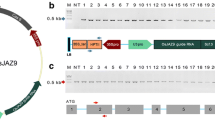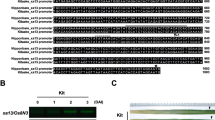Abstract
CRISPR/Cas9 system based on the adaptive immune system of bacteria is an emerging powerful technique of genome editing. Previously, we showed that transgenic rice transformed with a recombinant CRISPR/Cas9-OsJAZ9 binary plasmid display genetic chimerism in T0 generation, and the genetic chimerism includes homozygous and heterogeneous mutation of the target gene, OsJAZ9. The homozygous mutation of the T0 lines was stably transferred into the next generation, and all T1 plants of the T0 homozygous mutants were homozygous mutants. However, the fate of T1 plants with heterogeneous mutation remains poorly understood. In this study, we characterized target gene mutation in the progenies of the T0 lines with heterogeneous mutation to understand fate of the T0 lines with heterogeneous mutation. We found that some T0 lines such as lines 6 and 21 produce the T1 plants carrying homozygous mutation of OsJAZ9 through genetic segregation, while other T0 lines such as lines 3, 4 and 15 did not produce homozygous mutants in T1 generation unlike lines 6 and 21. These indicated that 40% of T0 lines with heterogeneous mutation produce the plants with homozygous mutation in T1 generation, suggesting that every T0 heterogeneous line does not produce the progenies with homozygous mutation through genetic segregation. However, because the portion of T0 lines with heterogeneous mutation (61%) is much bigger than that of T0 lines with homozygous mutation (8%) in T0 pool, these results propose that T0 heterogeneous mutants are useful to obtain CRISPR/Cas9-mediated homozygous mutants.






Similar content being viewed by others
References
Barrangou R, Fremaux C, Deveau H, Richards M, Boyaval P, Moineau S, Romero DA, Horvath P (2007) CRISPR provides acquired resistance against viruses in prokaryotes. Science 315:1709–1712
Bhaya D, Davison M, Barrangou R (2011) CRISPR-Cas systems in bacteria and archaea: versatile small RNAs for adaptive defense and regulation. Annu Rev Genet 45:273–297
Bortesi L, Fischer R (2015) The CRISPR/Cas9 system for plant genome editing and beyond. Biotechnol Adv 33:41–52
Brouns SJ, Jore MM, Lundgren M, Westra ER, Slijkhuis RJ, Snijders AP, Dickman MJ, Makarova KS, Koonin EV, Van Der Oost J (2008) Small CRISPR RNAs guide antiviral defense in prokaryotes. Science 321:960–964
DiCarlo JE, Norville JE, Mali P, Rios X, Aach J, Church GM (2013) Genome engineering in Saccharomyces cerevisiae using CRISPR-Cas systems. Nucleic Acids Res 41:4336–4343
Doudna JA, Charpentier E (2014) The new frontier of genome engineering with CRISPR-Cas9. Science 346:1077
Fineran PC, Charpentier E (2012) Memory of viral infections by CRISPR-Cas adaptive immune systems: acquisition of new information. Virology 434:202–209
Gasiunas G, Barrangou R, Horvath P, Siksnys V (2012) Cas9–crRNA ribonucleoprotein complex mediates specific DNA cleavage for adaptive immunity in bacteria. Proc Natl Acad Sci 109:E2579–E2586E2579–E2586
Hsu PD, Scott DA, Weinstein JA, Ran FA, Konermann S, Agarwala V, Li Y, Fine EJ, Wu X, Shalem O (2013) DNA targeting specificity of RNA-guided Cas9 nucleases. Nat Biotechnol 31:827–832
Hsu PD, Lander ES, Zhang F (2014) Development and applications of CRISPR-Cas9 for genome engineering. Cell 157:1262–1278
Jang I-C, Nahm BH, Kim J-K (1999) Subcellular targeting of green fluorescent protein to plastids in transgenic rice plants provides a high-level expression system. Mol Breed 5:453–461
Jang G, Lee S, Um TY, Chang SH, Lee HY, Chung PJ, Kim J-K, Do Choi Y (2016) Genetic chimerism of CRISPR/Cas9-mediated rice mutants. Plant Biotechnol Rep 10:425–435
Jiang F, Doudna JA (2017) CRISPR–Cas9 structures and mechanisms. Annu Rev Biophys 46:505–529
Jinek M, Chylinski K, Fonfara I, Hauer M, Doudna JA, Charpentier E (2012) A programmable dual-RNA–guided DNA endonuclease in adaptive bacterial immunity. Science 337:816–821
Kanaar R, Hoeijmakers JH, van Gent DC (1998) Molecular mechanisms of DNA double-strand break repair. Trends Cell Biol 8:483–489
Khandagale K, Nadaf A (2016) Genome editing for targeted improvement of plants. Plant Biotechnol Rep 10:327–343
Lintner NG, Kerou M, Brumfield SK, Graham S, Liu H, Naismith JH, Sdano M, Peng N, She Q, Copié V (2011) Structural and functional characterization of an archaeal clustered regularly interspaced short palindromic repeat (CRISPR)-associated complex for antiviral defense (CASCADE). J Biol Chem 286:21643–21656
Lowder LG, Paul JW, Baltes NJ, Voytas DF, Zhang Y, Zhang D, Tang X, Zheng X, Hsieh T-F, Qi Y (2015) A CRISPR/Cas9 toolbox for multiplexed plant genome editing and transcriptional regulation. Plant Physiol 169:971–985
Lu Y, Zhu J-K (2017) Precise editing of a target base in the rice genome using a modified CRISPR/Cas9 system. Mol Plant 10:523–525
Mali P, Yang L, Esvelt KM, Aach J, Guell M, DiCarlo JE, Norville JE, Church GM (2013) RNA-guided human genome engineering via Cas9. Science 339:823–826
Mishra R, Zhao K (2018) Genome editing technologies and their applications in crop improvement. Plant Biotechnol Rep 12:57–68
Mojica FJ, Díez-Villaseñor C, Soria E, Juez G (2000) Biological significance of a family of regularly spaced repeats in the genomes of archaea, bacteria and mitochondria. Mol Microbiol 36:244–246
Platt RJ, Chen S, Zhou Y, Yim MJ, Swiech L, Kempton HR, Dahlman JE, Parnas O, Eisenhaure TM, Jovanovic M (2014) CRISPR-Cas9 knockin mice for genome editing and cancer modeling. Cell 159:440–455
Puchta H (2017) Applying CRISPR/Cas for genome engineering in plants: the best is yet to come. Curr Opin Plant Biol 36:1–8
Ran FA, Hsu PD, Wright J, Agarwala V, Scott DA, Zhang F (2013) Genome engineering using the CRISPR-Cas9 system. Nat Protoc 8:2281–2308
Shah SA, Erdmann S, Mojica FJ, Garrett RA (2013) Protospacer recognition motifs: mixed identities and functional diversity. RNA Biol 10:891–899
Shalem O, Sanjana NE, Hartenian E, Shi X, Scott DA, Mikkelsen TS, Heckl D, Ebert BL, Root DE, Doench JG (2014) Genome-scale CRISPR-Cas9 knockout screening in human cells. Science 343:84–87
Sharma S, Kaur R, Singh A (2017) Recent advances in CRISPR/Cas mediated genome editing for crop improvement. Plant Biotechnol Rep 11:193–207
Van de Wiel C, Schaart J, Lotz L, Smulders M (2017) New traits in crops produced by genome editing techniques based on deletions. Plant Biotechnol Rep 11:1–8
Voytas DF (2013) Plant genome engineering with sequence-specific nucleases. Annu Rev Plant Biol 64:327–350
Wiedenheft B, Sternberg SH, Doudna JA (2012) RNA-guided genetic silencing systems in bacteria and archaea. Nature 482:331–338
Wu Y, Liang D, Wang Y, Bai M, Tang W, Bao S, Yan Z, Li D, Li J (2013) Correction of a genetic disease in mouse via use of CRISPR-Cas9. Cell Stem Cell 13:659–662
Xie K, Yang Y (2013) RNA-guided genome editing in plants using a CRISPR–Cas system. Mol Plant 6:1975–1983
Xie K, Minkenberg B, Yang Y (2015) Boosting CRISPR/Cas9 multiplex editing capability with the endogenous tRNA-processing system. Proc Natl Acad Sci 112:3570–3575
Acknowledgements
This work was carried out with the support of “Cooperative Research Program for Agriculture Science and Technology Development [Project No. PJ01323901 to G.J.]” Rural Development Administration, Republic of Korea and the National Research Foundation of Korea Grant funded by the Korean Government (MOE) [NRF-2014R1A1A2054261 to Y.C.] and [NRF-2016R1D1A1B03931167 to G.J.].
Author information
Authors and Affiliations
Corresponding authors
Rights and permissions
About this article
Cite this article
Lee, S., Kim, JK., Choi, Y.D. et al. Segregation of genetic chimeras generated by CRISPR/Cas9 system in rice. Plant Biotechnol Rep 13, 35–42 (2019). https://doi.org/10.1007/s11816-018-0508-5
Received:
Accepted:
Published:
Issue Date:
DOI: https://doi.org/10.1007/s11816-018-0508-5




